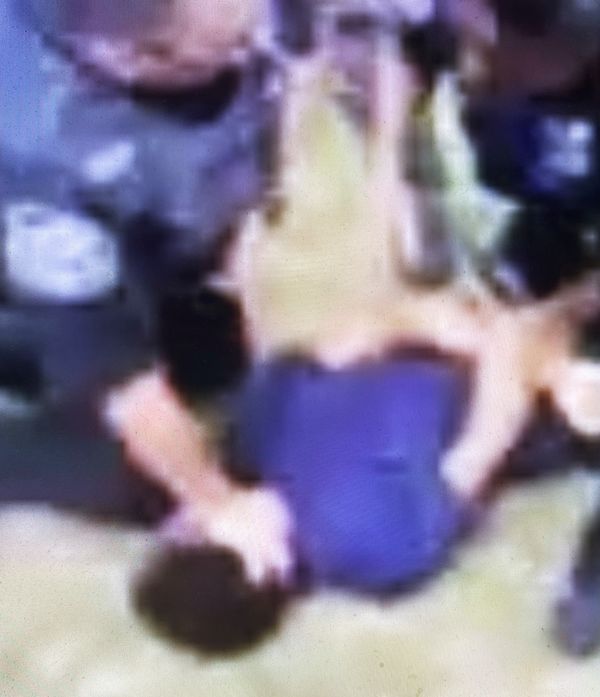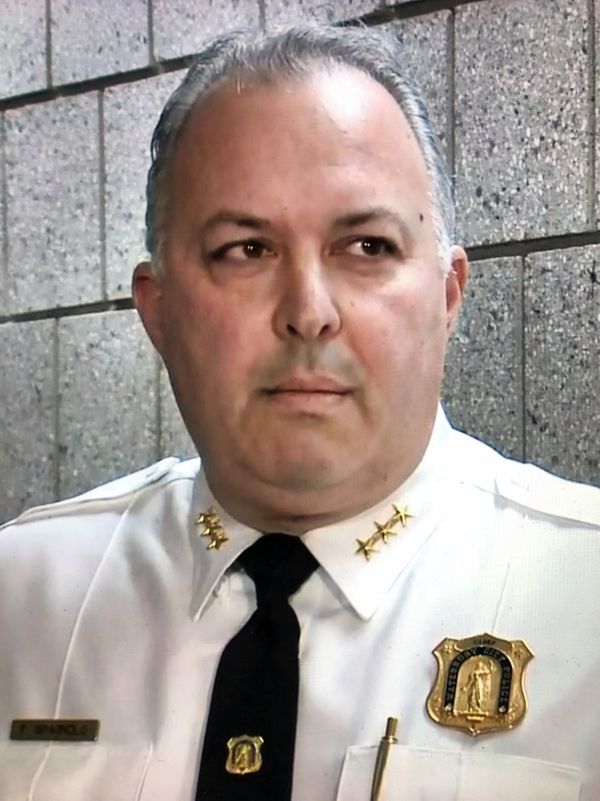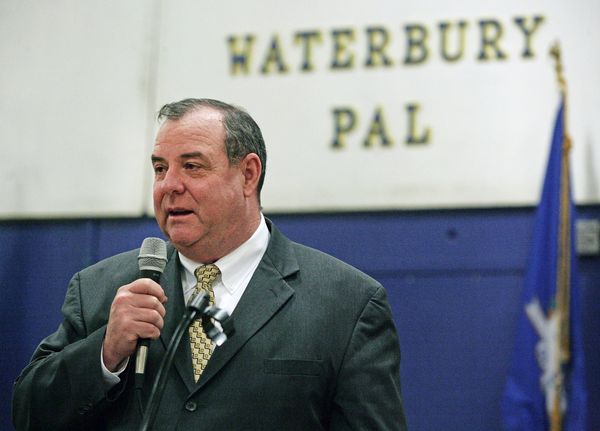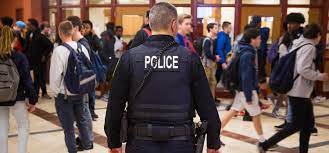(Subscribe to The Brass File to get it e-mailed directly to your in-box by clicking on the link at the bottom of this page. Thank you.)
Story By John Murray
The twenty second video was captured on a smart phone and forwarded to The Waterbury Observer with the comment, “Look what the police did to my nephew.”
That video, and a subsequent series of conversations with members of the Waterbury Police Department, has created a greater understanding of the complex issue of assigning police officers to safeguard public schools in Waterbury. Police in schools continues to be controversial – it was hotly debated during the 2020 Legislative Session in Hartford – with the dividing line (or different perspective) often coming down to skin color, and wealth.
Let’s begin with the video we received September 21st, 2021.
The video was blurry and captured a scene of chaos as students hollered and walked in front of the camera. All you could see at first was backpacks and feet, and then at seven seconds you could see Waterbury police officers pinning a student to the ground. One officer pressed the boy’s head into the dirt, while others subdued and handcuffed him. The student is 13 years old.

One of the West Side Middle School students arrested in a melee. |
We confirmed the incident with Sgt. Robert Davis, the spokesman for the Waterbury Police Department, and then we posted it on our Facebook page. Sgt. Davis told us that the fight occurred in the school parking lot during dismissal. One school staff member had intervened in an attempt separate two students fighting – before calling in police – but the students continued to exchange punches. The school resource officer assigned to the West Side Middle School saw the struggle and intervened. One student refused to stop fighting and a large crowd formed, and several other students got involved. Additional police units were dispatched to the school to assist with controlling the situation, and dispersing the crowd. Both students were arrested and a weapon was confiscated.

Weapon seized at Wallace Middle School. |
Two years ago Waterbury was roasted in the state media when a report compiled by the state’s child advocate, Sarah Eagan, revealed that Waterbury’s K-8 schools called the police hundreds of times in a six month period, calls that resulted in 198 arrests. The arrests at West Side Middle School, with a weapon involved, is understandable, but in 2018 Waterbury was responsible for 25% of all K-8 student arrests in Connecticut.
We asked our readers what they thought of having police officers in schools – not to specifically weigh in on the video – and asked whether calling the police on grammar school kids was the best way to handle discipline problems in the public schools. We received hundred s of comments and messages from our readers, many were 100% in support of police officers being called in to handle disturbances. There were dozens of comments directing the problem back to the parents, and proclaiming that students needed to learn respect.
Some of the comments went too far calling the children animals, and there were racial overtones in many comments as well. Some of the comments posted by older white readers (particularly white males) were strongly in favor of the police maintaining law and order in a public school system that is comprised of an overwhelming majority of Black and Brown students.
Last year during contentious police reform legislation in Hartford, State Senator Gary Winfield of New Haven, proposed that all police officers be removed from schools. Winfield believed police should not handle disciplinary issues in the schools.
“They’re police,” Winfield said. “they are not the people who should be giving discipline, nor should they ever have been.”
Police in schools are called School Resource Officers (SRO) and it’s a fairly new policy intended to keep students safe. The officers have largely been funded by federal dollars in response to the rash of school shootings since Columbine in the 1990s. In 1975 less than 1% of schools in America had a police presence and now, according to Center for Education Policy, 58% do.
In a Master’s Degree dissertation written by Chelsea Connery in October 2020 at the University of Connecticut titled, “The Prevalence and the Price of Police in Schools”, she wrote, “the use of SROs in schools reproduces unjust racialized patterns of discipline and state violence that exists outside of schools. White youth and youth of color are having vastly difference experiences of policing out of school, vastly different perceptions of police in school, and thus vastly different educational opportunities.”
Connery concluded, “creating safe schools for all students means avoiding overly simple reactionary solutions and doing the deep work of dismantling oppressive structures and building new structures to proactively address systemic root causes and unmet needs that lead to threats to safety.”
A 2013 Congressional Research Study found that schools with school resource officers may be more likely to report incidents like physical fights and threats to the police or to arrest students for low-level crimes. The study also noted that students in schools with resource officers were less likely to bring in weapons or commit assaults on school grounds.
One of the readers who commented on the Observer post on Facebook was Waterbury Chief of Police, Fred Spagnolo. He wrote that our post had come up short in describing the situation. A lot had happened inside the Waterbury Police Department and the Waterbury Public School System since the child advocate report had been published.
 |
“Mr. Murray’s comments regarding the 2018/2019 Office of Child Advocacy report fall short,” Spagnolo wrote. “During the preparation of that report and since its release the Waterbury Mayor’s office, education department and police department have worked tirelessly to address issues in our school community. Arrest rates have plummeted in the school years post 2018/2019.”
Spagnolo stated that forums had been created to solicit feedback and fresh ideas from the school population and advocates and activists in the community.
“Training has been provided to school administrators and staff regarding de-escalation,” Spagnolo wrote. “Training has been provided to Waterbury police officers regarding de-escalation and mentorship of youth.”
Spagnolo also reported, “that there is more being done now than ever before, and we are continuing to grow our services with new and innovative ideas and partnerships.”
One new initiative is a mentor program through PAL (Police Athletic League) funded through the state and the national PAL. A collaboration between Waterbury PD, educators, the CT Department of Children and Families (DCF) and a local non profit behavioral health agency is proactively meeting and identifying children exposed to trauma and providing services for them as well as their families.

Waterbury Mayor Neil O’Leary invigorated the PAL program in the city during his tenure as police chief. The program went from serving 50 children to more than 4000, and was nationally recognized. Chief Spagnolo is using PAL now for a mentor program. |
Another partnership has been formed with a non profit youth mentoring group of credible messengers known as “Ice the Beef” to assist with high-risk youth.
“Even with all of this and the commitment of the Mayor NeilO’Leary, School Superintendent Verna Ruffin and the police to seek alternative solutions to arrest in our schools, there will be times when the safety of thousands of students and tens of thousands of citizens in our community will need to be addressed by police,” Spagnolo said. “To me there is nothing worse than being a victim of a crime. When a small group of adolescent youth jeopardize nearly 850 others in one single incident by engaging in a fight and brining weapons on to school grounds the police need to be involved.”
The issue of posting police officers inside public schools remains contentious, but is not an issue that state legislators appear willing to tackle in the 2022 session. The issue, however, could be addressed on the local level. In April the New Haven Board of Education voted to begin a transition away from posting police officers in schools. The planned first step, reported in The New Haven Independent, is to invest more in school psychologists, counselors and social workers.
The New Haven Board of Ed made the commitment to begin a transition after a recommendation from its School Security Task Force. The task force rebuffed calls to immediately eliminate police in schools, and will begin a slow transition.
We don’t have the answers, but there had to be a better way for Waterbury to handle disturbances in public schools than arresting 198 students in K-8 in 2018. We can’t arrest our way out of this crisis, and when we called for city educators to rethink the use of Waterbury police officers as a first defense in handling discipline problems with students, we were unaware that that process was already vigorously underway.
“We want to be the last resort,” Police Chief Spagnolo said. “And for the past two years we have invested a lot of energy in exploring other avenues. We try to recognize and identify if a student’s problems are secondary to a bigger issue that was never explored; was his brother killed, is there substance abuse at home, is he hungry, has he been exposed to trauma? We’re now doing crisis intervention on the youth level before there is an explosion, and so far we are getting great results.”

